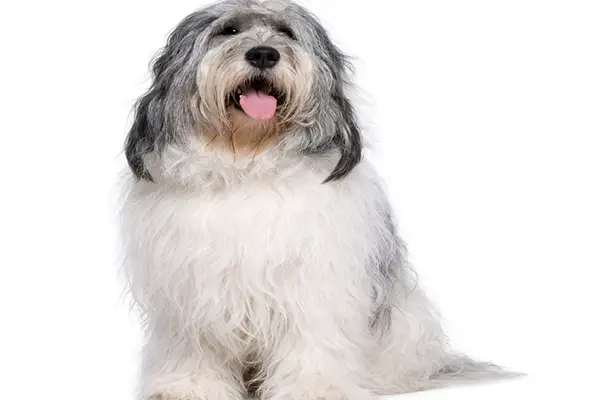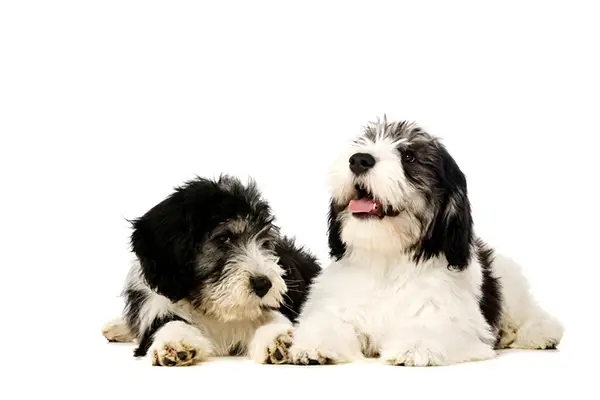Polish Lowland Sheepdogs are medium-sized dogs that usually stand at a height of 20 inches. The Polish Lowland Sheepdog has a muscular body that is covered with long, shaggy coat in black, white, brown, fawn, or gray colors. Facial hair usually covers their eyes that are also known for their penetrating gaze.
Polish lowland Sheepdogs are commonly known as Polski Owczarek Nizinny or PON for short. They have been assistants to the shepherds for centuries and are known for their great intelligence.
These dogs are the best fit for active families who can always provide him with something to do. However, you should also make sure that you’re always smarter than this dog. PONs are also known for their clownish personalities and will surely make your life even enjoyable.

Polish Lowland Sheepdog Statistics
| Dog Breed Group | Herding |
| Breed Size | Medium |
| Height | 18-20 inches (male); 17-19 inches (female) |
| Weight | 30-50 pounds |
| Lifespan | 12-14 years |
Polish Lowland Sheepdog Ratings
| Energy level | |
| Exercise needs | |
| Requires attention | |
| Playfulness | |
| Trainability | |
| Shedding | |
| Grooming | |
| Friendly with family | |
| Friendly with kids | |
| Friendly with strangers | |
| Friendly with other dogs | |
| Prey Drive |
History
Polish Lowland Sheepdogs are ancient dogs from Poland. As to how they developed, there were two theories.
One is that these dogs descended from dogs who traveled with the Huns. The dogs were then crossbred with native dogs in Poland, creating the PON. Another theory states that the PON might have descended from the Puli and Central Asian dogs, including the Tibetan Mastiff, Tibetan Spaniel, Lhasa Apso, and Tibetan Terrier.
Polish Lowland Sheepdogs are popular herding and flask-guarding dogs since the 15th century. They are also said to have been used to create the Bearded Collie that we know now.
When sheep herding declined in Poland, the need for the dogs also decreased. This affected their numbers, and things even got worse when World War II came.
Fortunately, a Polish veterinarian made it her goal to save the breed with her own PON. The breeding was such a success that all PONs’ roots can be traced back to that dog.
By 1959, a breed standard was finally written, and the breed was accepted to the Federation Cynologique Internationale.
By 1979, the first Polish Lowland Sheepdogs were imported to the US. However, it wasn’t until 2001 when the American Kennel Club finally recognized the dog, thanks to the efforts of Kaz and Betty Augustowski.
Today, the dogs rank 170th as the most popular dog in the US. Although they might still be considered rare in the US, they are said to be the most popular in their homeland.
Temperament
Polish Lowland Sheepdogs are confident, clever, and lively dogs. Bred to be working dogs, they sure are athletic and would require daily exercise.
They are the best fit for active owners who can find ways to exercise them physically and mentally. If you can meet this, then expect a calm, stable, and happy dog indoors.
You’ll find the PON to be devoted dogs. They are known to be good with children and other pets that are raised with them. However, be sure to keep close supervision to toddlers as these dogs may have tendencies to herd them.
Polish Lowland Sheepdogs can be aloof and suspicious to people outside their families. They are excellent watchdogs. They can also be dominant with strange dogs and have a strong prey drive.
Socialization is needed, so they know how to manage their behaviors well. It will also help them to become more well-rounded. Training is essential too, but you need to make sure that you’re consistent and firm.
These dogs tend to be independent thinkers, and they love getting what they want. Don’t let this happen, and be sure to take charge.

Polish Lowland Sheepdog Care Requirements
- Nutrition: Polish Lowland Sheepdogs don’t have any special dietary requirements as long as you feed them high-quality and well-balanced meals daily. It should also contain essential nutrients like proteins, fats, carbohydrates, vitamins, and minerals. Since they can survive on any diet, it’s your job to ensure that they only get high-quality ingredients for their meals. We highly recommend feeding your dog animal meat as their source of protein. For fats, you can get this from fish oil, and you can get carbohydrates from whole grains and sweet potatoes. Adding fruits and vegetables to your dog’s diet is great. These are excellent sources of vitamins and fiber, which will help in easy digestion. Dog food and dog treats must be of premium quality, too. This means they shouldn’t contain fillers, additives, and by-products that may cause your dog problems. You should also stay away from ingredients your dog is allergic to. If possible, ask your vet for advice regarding the best feeding requirement for your dog. This way, he can create a guide that is specific to your dog’s needs depending on his age, activity level, metabolism, etc.
- Grooming: Polish Lowland Sheepdogs are known for their long, shaggy double coats that may require lots of maintenance. Although these coats shed seasonally, you would need to brush it a couple of times a week, so it stays healthy. During the shedding season, it’s highly recommended to brush it daily. Bruising will help prevent mats and tangles while also removing debris and loose hair. Added to that, it’s great bonding for you and your dog. Baths can be given once every 1-2 months as they can get dirty easily. However, you should ensure that the ears are checked and cleaned regularly, weekly if possible. Trim the nails too, so your dog always stays comfortable. If you’re having a hard time with your dog’s coat, then we highly recommend going to a professional groomer, especially if you’re inexperienced. This way, they can also teach you of the best ways to keep your dog’s hair healthy.
- Exercise: Polish Lowland Sheepdogs are energetic and athletic dogs who need their daily exercise. We highly recommend having a large securely-fenced yard to let your dog run around on his own. However, if you don’t have a large yard, you can take them out for long walks or hikes. Play sessions are also a great form of exercise for your dog. And if you’re joining in sports events, training should suffice in keeping their growing muscles healthy.
- Health: Polish Lowland Sheepdogs are generally healthy dogs with a long lifespan. However, like any other dog breeds, there will always be health conditions they are susceptible to. For these dogs, canine hip dysplasia and progressive retinal atrophy are very common. We recommend having your dog take some screening tests to detect these two conditions early. Other genetic conditions may also appear, so be sure to meet at least one of your dog’s parents to be aware of this. We also want to emphasize the importance of continuously observing your dog’s behavior, and if you notice any changes, take him immediately to the vet.
- Lifespan: The life expectancy of Polish Lowland Sheepdogs is 12-14 years.
Famous Polish Lowland Sheepdogs
- Psyche: A Polish Lowland Sheepdog that is said to have the ability to predict where the bomb would drop during the war
- Smok: The Polish Lowland Sheepdog responsible for saving the breed.
Fun Facts about Polish Lowland Sheepdogs
- Polish Lowland Sheepdogs appeared in Poland around the 1500s.
- They are believed to have descended from herding dogs brought by the Huns to Europe.
- These dogs are more known for their nickname, Polski Owczarek Nizinny, or PON for short.
- They almost became extinct during the war, where only 150 remained.
- They are featured on Polish stamps.
- They are ancestors of the Bearded Collie.
- They were recognized by the American Kennel Club in 2001.
Check Out Other Herding Dog Breeds:
Australian Cattle Dog, Australian Shepherd, Bearded Collies, Beaucerons, Belgian Malinois, Belgian Sheepdog, Belgian Tervuren, Bergamasco Sheepdog, Berger Picards, Border Collie, Bouviers des Flandres, Briards, Canaan Dog, Cardigan Welsh Corgis, Collie, Entlebucher Mountain Dogs, Finnish Lapphund, German Shepard, Miniature American Shepherd, Norwegian Buhunds, Old English Sheepdog, Pembroke Welsh Corgi, Puli, Pumi, Pyrenean Shepherd, Shetland Sheepdog, Spanish Water Dog, Swedish Vallhunds
